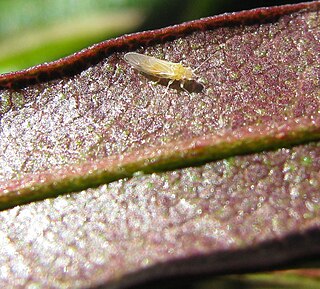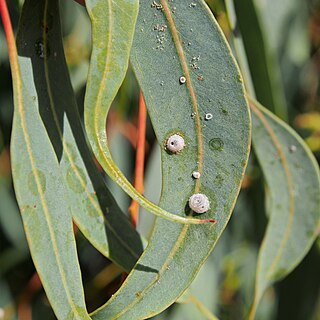
Psyllidae, the jumping plant lice or psyllids, are a family of small plant-feeding insects that tend to be very host-specific, i.e. each plant-louse species only feeds on one plant species (monophagous) or feeds on a few closely related plants (oligophagous). Together with aphids, phylloxerans, scale insects and whiteflies, they form the group called Sternorrhyncha, which is considered to be the most "primitive" group within the true bugs (Hemiptera). They have traditionally been considered a single family, Psyllidae, but recent classifications divide the group into a total of seven families; the present restricted definition still includes more than 70 genera in the Psyllidae. Psyllid fossils have been found from the Early Permian before the flowering plants evolved. The explosive diversification of the flowering plants in the Cretaceous was paralleled by a massive diversification of associated insects, and many of the morphological and metabolic characters that the flowering plants exhibit may have evolved as defenses against herbivorous insects.
Coextinction and cothreatened refer to the phenomena of the loss or decline of a host species resulting in the loss or endangerment of an other species that depends on it, potentially leading to cascading effects across trophic levels. The term originated by the authors Stork and Lyal (1993) and was originally used to explain the extinction of parasitic insects following the loss of their specific hosts. The term is now used to describe the loss of any interacting species, including competition with their counterpart, and specialist herbivores with their food source. Coextinction is especially common when a keystone species goes extinct.

Acacia pycnantha, most commonly known as the golden wattle, is a tree of the family Fabaceae. It grows to a height of 8 metres and has phyllodes instead of true leaves. The profuse fragrant, golden flowers appear in late winter and spring, followed by long seed pods. Explorer Thomas Mitchell collected the type specimen, from which George Bentham wrote the species description in 1842. The species is native to southeastern Australia as an understorey plant in eucalyptus forest. Plants are cross-pollinated by several species of honeyeater and thornbill, which visit nectaries on the phyllodes and brush against flowers, transferring pollen between them.

Pleistodontes froggatti is a species of fig wasp which is native to Australia. It has an obligate mutualism with the Moreton Bay Fig, Ficus macrophylla, the species it pollinates. Outside Australia, populations have become established in Hawaii and New Zealand where it was either accidentally introduced or arrived by long-distance dispersal.

Zebra chip, also known as papa manchada and papa rayada, is a disease in potatoes putatively caused by an alphaproteobacterium "Candidatus Liberibacter solanacearum", which is vectored by the potato psyllid. When fried, potato tubers from infected plants develop unsightly black lines resembling the stripes of zebras that render the chips unsellable. Additionally, striped sections of chips frequently burn and caramelize, resulting in a bitter flavor. No health risks have been connected with consumption of infected potato chips.

Jalmenus evagoras, the imperial hairstreak, imperial blue, or common imperial blue, is a small, metallic blue butterfly of the family Lycaenidae. It is commonly found in eastern coastal regions of Australia. This species is notable for its unique mutualism with ants of the genus Iridomyrmex. The ants provide protection for juveniles and cues for adult mating behavior. They are compensated with food secreted from J. evagoras larvae. The ants greatly enhance the survival and reproductive success of the butterflies. J. evagoras lives and feeds on Acacia plants, so butterfly populations are localized to areas with preferred species of both host plants and ants.

Acizzia dodonaeae is a psyllid common on Dodonaea viscosa.

Acizzia uncatoides is a species of psyllid native to Australia where it feeds primarily on Acacia and some Albizia species. It is present in many parts of the world where it infests these plant species, presumably introduced with the plants. It is not generally regarded as a pest species although it can proliferate to high numbers. Generalist psyllid predators also feed on this species.
Aacanthocnema is a genus of bugs from the jumping plant lice family (Triozidae). The genus is endemic to Australia, and currently contains six species, found in all states and territories with the exception of the Northern Territory.
Acrocercops plebeia is a moth of the family Gracillariidae. It is known from Queensland, Victoria and New South Wales, Australia.

Trichilogaster is a small genus of chalcid wasps in the family Melanosomellidae, previously they were included in family Pteromalidae subfamily Ormocerinae. With one described exception, they all are Australian species that are gall-formers on Australian species of Acacia. The exception is an Arabian species. Apart from its ecological interest, the genus is of practical importance because some of its members are successful biocontrol agents in South Africa at least, where T. acaciaelongifoliae and T. signiventris have been established successfully to control invasive Australian Acacia species, notably Acacia longifolia and Acacia pycnantha.

Acizzia solanicola is a psyllid from Australia, found on plants of the genus Solanum. It has subsequently been found also in New Zealand.

Homotomidae is a family of small phloem-feeding bugs in the superfamily Psylloidea, or jumping plantlice.
Brakothrips is a genus of thrips in the family Phlaeothripidae, first described by Crespi, Morris and Mound in 2004. The type species is Brakothrips gillesi. Insects in this genus are found only in Australia, living under the splitting bark of young branches of Acacias.

Trioza adventicia, commonly known as the syzygium leaf psyllid, lillypilly psyllid, or eugenia psyllid, is a sap-sucking hemipteran bug in the family Triozidae which creates galls on the leaves of Syzygium paniculatum. This species is native to eastern Australia and has been introduced into California, southern Australia, and New Zealand.

Glycaspis is a genus of plant-parasitic insects in the family Aphalaridae. There are at least two described species in Glycaspis.

Calomela bartoni is a beetle in the Chrysomelidae family, which is found in New South Wales and Victoria.
Mcateella is a genus of ash-grey leaf bugs, insects of the family Piesmatidae, first described by Carl John Drake in 1924 The genus name honours Waldo Lee McAtee. The genus is endemic to Australia and is found in all mainland states and territories, with the exception of Victoria and the ACT.

Pauropsalta is a genus of cicadas belonging to the family Cicadidae, first described in 1904 by Frederic Webster Goding and Walter Wilson Froggatt.
Pauropsalta extrema is a cicada, in the Cicadettini tribe of the cicada family, Cicadidae, first described by William Lucas Distant in 1892, as Melampsalta extrema, and transferred to the genus, Pauropsalta, in 1904 by Frederic Webster Goding and Walter Wilson Froggatt.
















